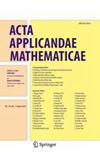欧拉-科里奥利方程线性衰减率的直接证明
IF 1.2
4区 数学
Q2 MATHEMATICS, APPLIED
引用次数: 0
摘要
本文给出了\(L^{\infty }\)时空中Euler-Coriolis方程\(t^{-1}\)(最优)线性衰减率的直接证明。我们的证明是基于显式解的适当分解和对核的\(L^{\infty }\)估计,它捕获了色散机制。本文章由计算机程序翻译,如有差异,请以英文原文为准。
A Direct Proof of Linear Decay Rate for Euler-Coriolis Equations
In this paper, we give a direct proof of \(t^{-1}\) (optimal) linear decay rate for Euler-Coriolis equations in \(L^{\infty }\) space-time. Our proof is based on a proper decomposition of the explicit solution and \(L^{\infty }\) estimate for the kernels, which captures the dispersive mechanism.
求助全文
通过发布文献求助,成功后即可免费获取论文全文。
去求助
来源期刊

Acta Applicandae Mathematicae
数学-应用数学
CiteScore
2.80
自引率
6.20%
发文量
77
审稿时长
16.2 months
期刊介绍:
Acta Applicandae Mathematicae is devoted to the art and techniques of applying mathematics and the development of new, applicable mathematical methods.
Covering a large spectrum from modeling to qualitative analysis and computational methods, Acta Applicandae Mathematicae contains papers on different aspects of the relationship between theory and applications, ranging from descriptive papers on actual applications meeting contemporary mathematical standards to proofs of new and deep theorems in applied mathematics.
 求助内容:
求助内容: 应助结果提醒方式:
应助结果提醒方式:


